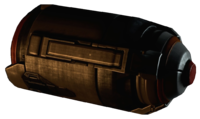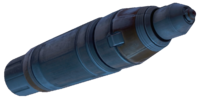HAVOK tactical nuclear weapon
From Halopedia, the Halo wiki
Template:Weapon The HAVOK tactical nuclear weapon is a UNSC nuclear weapon produced by the Misriah Armory. It is classified as part of the Medium Fusion Destructive Device category.[1]
Variants
Several variants of the HAVOK nuclear device have been developed for use in different tactical situations, from ordnance deployed by ground forces to missile-based delivery systems.
HAVOK nuclear mine
The HAVOK tactical nuclear mine[2] is one of the most powerful ground-based nuclear ordnance in the UNSC arsenal, and has a thermonuclear yield of 30 megatons. It is described as looking like a small black half sphere, and does not contain any external indicators; the device only contains a thin slot on the unit's face to allow the detonation key to be inserted. The bottom of the unit contains bonding strips that allows the HAVOK to be attached to any type of surface. The mine can only be detonated by a remote signal, and if the device is placed underneath thick concrete and steel, or other objects that may cause interference, a ground-return receiver must be set up to allow the signal to reach the device.[3]
The HAVOK mine is used in situations where the UNSC must eliminate enemy forces in an area already claimed by them, or to prevent an area from falling into their hands. However, there are situations where the UNSC will use a HAVOK to eliminate Covenant ships deploying infantry and equipment. Nuclear weapons like the HAVOK are employed often but not always, and are only used when all civilian and military populations have been either evacuated, or compromised in a target area.
Variant V
The Variant V HAVOK is designed to maximize the thermonuclear yield in the vacuum of space.[4] The Variant V HAVOK is a warhead that is attached to a missile and can be launched from either the ground or from a ship.[5]
Mark 2521 MFDD
The Mark 2521 Medium Fusion Destructive Device is an excavation-grade variant of the weapon. It can be carried on a Pelican and can be stuck on a surface.[6]
Mark 2550 MFDD
The Havok Bunker Buster 2550 Medium Fusion Destructive Device is an excavation-grade variant of the Havok tactical nuclear weapon that is deployed via airdrop. As a medium-yield nuclear device, the BB 2550 gives off a relatively small amount of radiation when compared to other nuclear weaponry.[7] The device can be armed with an adjustable set timer. After a Havok BB 2550 is airdropped from an aircraft, the nuclear device deploys three helical fins to stabilize its fall.[8] As a bunker-buster weapon, the Mark 2550 is designed to direct most of the energy of the blast downward to maximize damage to subterranean targets.[9]
Mark 2556 MFDD
The Mark 2556 Medium Fusion Destructive Device[10] is an excavation-grade variant of the weapon, presumably used for excavation purposes in locations where a nuclear blast is required. A singly warhead of this variant is stated to be able to turn Ivanoff Station "into piñata". [11] Despite being excavation-grade, it could be attached to an F-41 Broadsword fighter in the form of a missile for ship-killing purposes. A single warhead was capable of destroying both the Composer and the powerful Forerunner vessel Mantle's Approach when detonated inside of the ship.[12]
Tactical uses
HAVOK Variant V nuclear missiles were carried on the UNSC Spirit of Fire in 2531.[5]
On February 12, 2535 during the Battle of Jericho VII, UNSC NavSpecWep deployed three teams of SPARTAN-IIs on Jericho VII to combat Covenant forces invading the colony. At one point during the engagement Red Team was successfully able to plant a HAVOK nuke near a Covenant rally point where a cruiser was to deploy ground forces while Blue Team was to clear out the rear guard of the Covenant forces so they could slip in. The plan was for the nuke to be detonated when the cruiser lowered its shields and landed to drop troops in order to take it out. Red Team succeeded in this mission.
In May, 2545, the 53rd Armored Division of the UNSC Army detonated two HAVOKs to demolish three Covenant staging grounds during the Battle of Actium. The blasts wiped out much of the Covenant ground forces, but at the cost of no less than 12,000 Army personnel. The battle ultimately ended in a Covenant victory, as Actium was glassed.
On July 18, 2552, during the Battle of Sigma Octanus IV, Blue Team detonated a HAVOK nuclear mine in the city of Côte d'Azur, during the battle taking place on the planet, destroying the city and all the Covenant in it.[13]
In October-November 2552, HAVOK nuclear weapons were used during the Battle of Earth. One notable use was when Blue Team was deployed to Mount Erebus in the Antarctic to destroy a Covenant excavation force using a HAVOK.[14]
In 2553, to destroy a Forerunner installation located in the Montero Cave System on Gao, Blue Team dropped a Havok BB 2550 nuke into an opening in the caverns which detonated and destroyed the installation.[8] During the Mission to Alpha Shard, Randall Aiken manually set off a HAVOK nuke destroying the bioweapon deposits on Alpha Shard. The HAVOK's emergency fuel cell was used to power the Condor in order to let Jameson Locke and Talitha Macer have a chance to get off of the Shard but this meant that the weapon required a manual detonation.[15]
Seven excavation-grade HAVOK warheads were stored on Ivanoff Station, presumably for excavation purposes rather than tactical ones given Ivanoff's status as a research station.. During the Raid on Ivanoff Station by the Didact, the Master Chief had all of the warheads prepared in order to destroy the Composer and prevent the Didact from getting it. After the Didact digitized everyone in the station, the Master Chief took one of these nukes in the form of a missile attached to an F-41 Broadsword fighter and chased the Didact. During the Didact's subsequent attack on Earth, the Master Chief boarded the Didact's ship, Mantle's Approach with the nuke and detonated it, destroying the ship and the Composer.[11]
In the aftermath of the ship's destruction, a Sangheili terrorist attempted to destroy the city of Rio de Janeiro with a smuggled HAVOK warhead; he was ultimately stopped by UNSC special forces operatives.[16]
During the Requiem Campaign, Jul 'Mdama's Covenant stole at least seven HAVOK-class warheads from the UNSC. During a raid on the UNSC Infinity, the Covenant planted one HAVOK in the ship's Server Room, and six more throughout the Engine Room. The HAVOKs were equipped with active camouflage to hide them from the ship's sensors. However, Fireteam Crimson was able to locate and disarm all the HAVOKs before they could be detonated.[17]
Trivia

|
Browse more images in this article's gallery page. |
- In the Spartan Ops chapter Engine of Destruction, if the player looks closely at the displays for the nukes, it will read "HAVOK Missle Controls Disarmed". The spelling error is presumably an oversight.
- The effects of the HAVOK nuclear weapon vary significantly between works of Halo media. In the weapon's first appearance in Halo: The Fall of Reach, the HAVOK tactical nuke is said to have a yield of 30 megatons, and descriptions of detonations in The Fall of Reach produce damage on a local scale. When the weapon is shown going off on Sigma Octanus IV in Halo: Fall of Reach - Covenant, it produces a continental-scale fireball that extends out into space and appears to break off pieces of the planet's crust, effects magnitudes more powerful than described in the novels. Conversely, in Issue 12 of Halo: Escalation, two HAVOKs dropped into a volcano-based pirate hideout cause significant damage to the base, yet do not critically endanger the Spartans inside. In Halo: Nightfall, Jameson Locke implies that the HAVOK has a blast radius of 100 kilometers. The screen on the device later specifies that the weapon causes complete destruction within seven kilometers, and light damage for 44 kilometers. However, when the nuke's detonation is shown, the fireball completely overwhelms Alpha Shard's width of 318 kilometers. While some the more egregious incongruities are likely the result of mistakes or artistic license, it is possible that like modern nuclear weapons, HAVOK weapons have variable yields. Additionally, variants of the HAVOK may have differing yields by default. The yield of the HAVOK used to destroy Mantle's Approach in Halo 4 is not given, but Cortana states that a single device can turn Ivanoff Station "into piñata." It was only stated to be an excavation-grade device, suggesting that the weapon likely had a lower yield than what is used by the military. Detonated inside Mantle's Approach near the Composer, the HAVOK was powerful enough to destroy both the Forerunner vessel and the Composer itself.
- In Halo: The Fall of Reach - The Animated Series, a Pelican during the Battle of Chi Ceti is armed with HAVOK nukes, one of which is used to destroy the Covenant ship. This contradicts the novel Halo: The Fall of Reach where the Pelican is only armed with standard missiles which are what is used to destroy the Covenant ship. This change was likely done for plot purposes in the animated series as it is the only place showing Pelicans armed with nuclear weapons.
Gallery
Concept art of the HAVOK missile and warhead for Halo 4.
In-game view of a HAVOK tactical nuclear warhead, mounted on the back of John-117's armor.
HAVOK missiles impact a pirate base on Ven III.
List of appearances
- Halo: The Fall of Reach (First appearance)
- Halo: Ghosts of Onyx
- Halo Wars: Genesis
- Halo 4
- Halo: Escalation
- Halo: Nightfall
- Halo: Last Light
- Halo: The Fall of Reach - The Animated Series
- Halo 5: Guardians
- Limited Edition (Mentioned only)
- Halo: Ground Command (Mentioned only)
- Halo: Envoy
- Halo: Retribution
Sources
- ^ Cite error: Invalid
<ref>tag; no text was provided for refs namedH4VG - ^ Halo: The Fall of Reach, page 177 (2001)
- ^ Cite error: Invalid
<ref>tag; no text was provided for refs namedtfor200 - ^ See talk page under subject "On HAVOK Nuclear Warhead"
- ^ a b Halo Wars: Genesis, page 17
- ^ Halo: The Fall of Reach - The Animated Series - Act 3
- ^ Halo: Last Light, page 325
- ^ a b Halo: Last Light, pages 376-380
- ^ Halo: Last Light, page 364 (Google Play edition)
- ^ Halo 4: The Essential Visual Guide, page 83
- ^ a b Halo 4, campaign level Composer
- ^ Halo 4, campaign level, Midnight
- ^ Halo: The Fall of Reach, page 212
- ^ Halo: Ghosts of Onyx, page 203
- ^ Halo: Nightfall, Chapter 5 Devil Takes the Hindmost
- ^ Spartan Ops, S1E01 Departure
- ^ Spartan Ops, Episodes Scattered & Invasion









